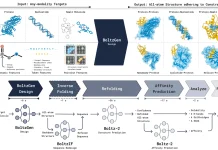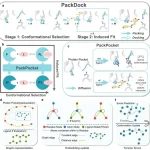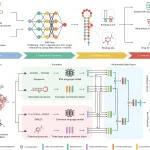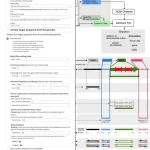A recent study published in Nucleic Acids Research has unveiled a critical role played by DdrC. The researchers found out that it can work as a repairer of damages and also a preventer of the same. It acts like a sentry patrolling DNA for damage signs. Researchers have been fascinated by Deinococcus radiodurans for some time because it is capable of rapidly fixing damaged DNA. This process revolves around the DdrC protein, which serves as a defender for protecting the bacterium’s genomic material from harm. Although previous research suggested its involvement in DNA repair, detailed mechanisms for that were not known.
DdrC: A Guardian of Genetic Integrity
DdrC, also referred to as DNA Damage Repair Protein C, DdrC is an important protein that plays a crucial role in safeguarding DNA from any damage whatsoever. It guards against anything menacing its genetic material, just like a watchman would do. Some earlier studies had pointed to such roles in DNA repairing but its actual participation and mode remained obscure.
This new research provides further insight into DdrC, revealing that it can act to both mend and also prevent breakages in DNA. In addition, the study showed that binding with single-stranded and double-stranded breaks in Deinococcus radiodurans can be accomplished by Ddrc acting as a sort of molecular clamp to stabilize an injured region.
How DdrC Works Its Magic
Imagine DNA as a lengthy and extremely delicate thread. When this thread is damaged, it can get broken or nicked. Fortunately, DdrC, a protein superhero, comes to the rescue. DdrC acts as a molecular bridge. It recognizes these breaks in the DNA and attaches itself to them. Instead of only mending the rupture, DdrC does something remarkable by pulling together the disrupted ends themselves. Think of it like gathering up and tying off the loose ends of a torn thread.
DNA compaction is crucial for several reasons:
- Protection: By bringing the fractured ends closer, DdrC reduces further chances of breakage. This is akin to covering up an injury to prevent infection.
- Stability: Compactifying DNA makes it more stable, preventing fragility and loss of extremities.
- Efficient Repair: By drawing isolated broken fragments closer together, DdrC prepares the ground for better functioning repair machinery, just like keeping all necessary tools for a repair job in one place.
Thus, damaged and loose DNA gets transformed into compactly packed, protected packages that provide a safe environment for repair processes. This breakthrough approach demonstrates how intricate cellular defenses can be used in practice efficiently.
DdrC: A Structural Marvel
To study how DdrC works at a molecular level, researchers established its 3D structure. They discovered that DdrC is a homodimer, which consists of two identical proteins. Intriguingly, this dimer has an asymmetrical structure, which is one unique aspect that contributes significantly to its functions. Furthermore, additional knowledge about interactions between DdrC and DNA was provided through computational modeling studies. The protein appears to have two distinct sites for binding DNA: one site binds general DNA while the other specifically recognizes and binds breaks in the chemical strand.
Implications and Future Directions
This discovery has brought forth multiple possibilities for future research as well as applications associated with DNA repair via DDR pathways. Exploring ways by which this protein saves DNA from destructive influence can lead to novel therapeutic strategies for resolving diseases like cancer caused by damage to the cellular genome.
Moreover, because of the ability of DdrC to compact DNA, there could be potential implications for nanotechnology and materials science. By using such a function as Ddrc’s mimicry, it may be possible to develop new means for shaping DNA among other biomolecules.
Conclusion
This is a new era of understanding how life fights against genetic damage, with the discovery of DdrC’s intricate role in DNA repair. Life at the molecular level is flexible and adaptable, as seen in both its protector and repairer, DdrC. The mysteries that surround this exceptional protein are being unraveled through further research, which may lead to significant achievements in the fields of biotechnology and medicine.
Numerous possibilities can arise from these studies, such as developing new cancer therapies or more resistant crops using knowledge from DdrC.
The journey towards understanding DdrC has just begun. Through each revelation, we get nearer to availing ourselves of this molecular sentinel for humanity’s sake.
What do you think about DdrC compacting and fixing DNA? Can it help find cures for diseases caused by damaging DNA strands? Tell us what you think, or ask us anything in our comments section!
Article Source: Reference Paper | Reference Article
FAQs
The DNA of Deinococcus radiodurans can be repaired after it has been exposed to high levels of radiation. A significant portion of the resilience can be attributed to the fact that it has efficient mechanisms for repairing DNA, such as proteins like DdrC.
DdrC is a protein that, when bonded with destroyed DNA, repairs it by restoring its integrity. Folding circular DNA and also circularizing linear ones, in this way, stabilizes damaged regions and creates a more conducive environment for repair enzymes.
A deeper understanding of how DdrC functions in DNA repair offers interesting prospects for innovative treatment options. Having the ability to mimic or improve what DdrC does might give cancer and other DNA damage-related illnesses a run for their money.
Future studies will concentrate more on the specific molecular mechanisms by which DDRc carries out its tasks, interactions with other proteins responsible for fixing DNA damage, and targeted biotechnological and medicinal applications. There is also interest among scientists in exploring how this amazing protein can benefit humanity.
Follow Us!
Learn More:
Anchal is a consulting scientific writing intern at CBIRT with a passion for bioinformatics and its miracles. She is pursuing an MTech in Bioinformatics from Delhi Technological University, Delhi. Through engaging prose, she invites readers to explore the captivating world of bioinformatics, showcasing its groundbreaking contributions to understanding the mysteries of life. Besides science, she enjoys reading and painting.
















